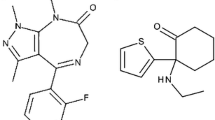Abstract
The inappropriate or illegal use of propofol has recently come to the fore as a serious social issue in South Korea. Thus, in spite of its superior potency as a therapeutic drug, propofol was classified as a controlled drug under the purview of Narcotics Control Law in South Korea in February of 2011. Accordingly, the determination of propofol and/or its metabolites in biological specimens is required to prove ingestion. Therefore, to demonstrate chronic ingestion, a quantitative analytical method for propofol-glucuronide in hair was developed and validated using liquid chromatography-tandem mass spectrometry (LC-MS/MS). This method was applied to measure propofol-glucuronide in hair samples from 23 propofol abuse suspects and in both pigmented and nonpigmented hair from rats which had ingested propofol. Propofol-glucuronide in hair was extracted in methanol and then filtered and analyzed by LC-MS/MS with electrospray ionization in negative mode. The validation results of selectivity, matrix effect, recovery, linearity, precision and accuracy, and processed sample stability were satisfactory. The limit of detection was 20 pg/10 mg hair and the limit of quantification was 50 pg/10 mg hair. The concentration range of propofol-glucuronide in hair segments from 23 propofol abuse suspects was shown up to 1,410 pg/mg. The animal study demonstrated that the presence of melanin did not affect the deposition of propofol-glucuronide in hair. Thus, we propose propofol-glucuronide in hair as a marker for propofol abuse. This method will be very useful for monitoring the inappropriate use of propofol for both legal and public health aspects.


Similar content being viewed by others
References
Kotani Y, Shimazawa M, Yoshimura S, Iwama T, Hara H (2008) The experimental and clinical pharmacology of propofol, an anesthetic agent with neuroprotective properties. CNS Neurosci Ther 14:95–106
Favetta P, Degoute CS, Perdrix JP, Dufresne C, Boulieu R, Guitton J (2002) Propofol metabolites in man following propofol induction and maintenance. Br J Anaesth 88:653–658
Guitton J, Buronfosse T, Desage M, Flinois JP, Perdrix JP, Brazier JL, Beaune P (1998) Possible involvement of multiple human cytochrome P450 isoforms in the liver metabolism of propofol. Br J Anaesth 80:788–795
Seo J (2011) Forensic review of propofol induced deaths—analysis of 33 autopsied cases. Annu Rep Nat Forensic Serv 43:35–42, Korean
Levy RJ (2011) Clinical effects and lethal and forensic aspects of propofol. J Forensic Sci 56(Suppl 1):S142–S147
Wilson C, Canning P, Caravati EM (2010) The abuse potential of propofol. Clin Toxicol 48:165–170
Marik PE (2004) Propofol: therapeutic indications and side-effects. Curr Pharm Des 10:3639–3649
Hayashi T, Buschmann C, Riesselmann B, Roscher S, Tsokos M (2013) Circumstantial and toxicological features of deaths from self-administered intravenous anesthetic/narcotic agents. Forensic Sci Med Pathol 9(2):138–144
Iwersen-Bergmann S, Rösner P, Kühnau HC, Junge M, Schmoldt A (2001) Death after excessive propofol abuse. Int J Legal Med 114:248–251
Colucci AP, Gagliano-Candela R, Aventaggiato L, De Donno A, Leonardi S, Strisciullo G, Introna F (2013) Suicide by self-administration of a drug mixture (propofol, midazolam, and zolpidem) in an anesthesiologist: the first case report in Italy. J Forensic Sci 58:837–841
Cohen S, Lhuillier F, Mouloua Y, Vignal B, Favetta P, Guitton J (2007) Quantitative measurement of propofol and in main glucuroconjugate metabolites in human plasma using solid phase extraction-liquid chromatography-tandem mass spectrometry. J Chromatogr B Anal Technol Biomed Life Sci 854:165–172
Lee SY, Park NH, Jeong EK, Wi JW, Kim CJ, Kim JY, In MK, Hong J (2012) Comparison of GC/MS and LC/MS methods for the analysis of propofol and its metabolites in urine. J Chromatogr B Anal Technol Biomed Life Sci 900:1–10
Cirimele V, Kintz P, Doray S, Ludes B (2002) Determination of chronic abuse of the anaesthetic agents midazolam and propofol as demonstrated by hair analysis. Int J Legal Med 116:54–57
Pragst F, Balikova MA (2006) State of the art in hair analysis for detection of drug and alcohol abuse. Clin Chim Acta 370:17–49
Kim J, Lee S, In S, Choi H, Chung H (2011) Validation of a simultaneous analytical method for the detection of 27 benzodiazepines and metabolites and zolpidem in hair using LC-MS/MS and its application to human and rat hair. J Chromatogr B Anal Technol Biomed Life Sci 879:878–886
Peters FT, Drummer OH, Musshoff F (2007) Validation of new methods. Forensic Sci Int 165:216–224
Matuszewski BK, Constanzer ML, Chavez-Eng CM (2003) Strategies for the assessment of matrix effect in quantitative bioanalytical methods based on HPLC-MS/MS. Anal Chem 75:3019–3030
Kintz P, Spiehler V, Negrusz A (2008) In: Jickells S, Negrusz A (eds) Clarke’s analytical forensic toxicology. Pharmaceutical Press, London
Kharbouche H, Steiner N, Morelato M, Staub C, Boutrel B, Mangin P, Sporkert F, Augsburger M (2010) Influence of ethanol dose and pigmentation on the incorporation of ethyl glucuronide into rat hair. Alcohol 44:507–514
Author information
Authors and Affiliations
Corresponding author
Rights and permissions
About this article
Cite this article
Kim, J., In, S., Park, Y. et al. Quantitative analysis of propofol-glucuronide in hair as a marker for propofol abuse. Anal Bioanal Chem 405, 6807–6814 (2013). https://doi.org/10.1007/s00216-013-7105-9
Received:
Revised:
Accepted:
Published:
Issue Date:
DOI: https://doi.org/10.1007/s00216-013-7105-9




